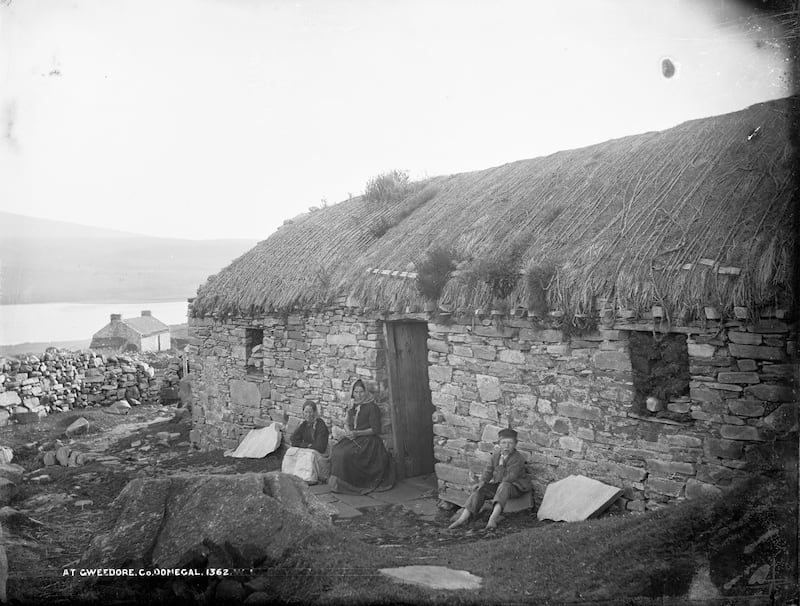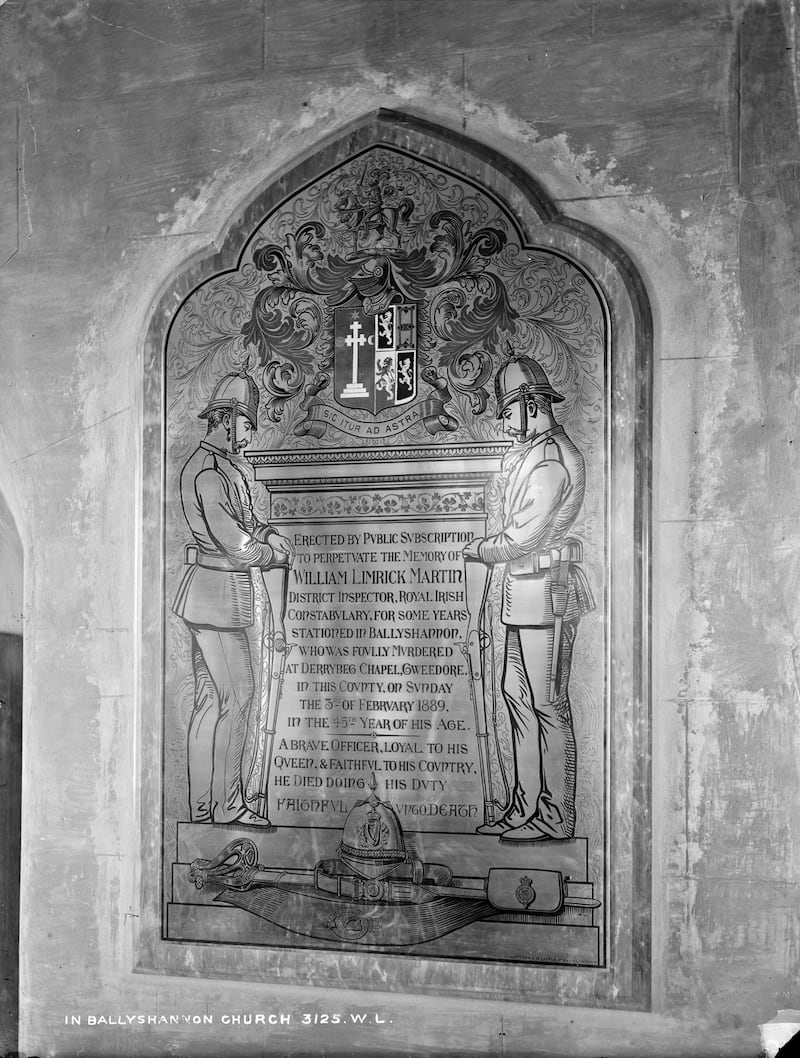As parish priest Fr James McFadden exited the chapel after saying Sunday Mass, he met a group of police officers waiting in the yard to arrest him.
Some locals attending the service on the morning of February 3rd, 1889, had remained behind. When police made a move to seize the priest, the crowd acted immediately. The chunks of rock dotted on the ground were put to use.
That morning had seen a gathering of the Royal Irish Constabulary travel to the chapel to intercept Fr McFadden, who was charged with conspiracy under the Criminal Law and Procedure (Ireland) Act, 1887. That legislation granted greater power to police in relation to agrarian crimes and agitation associated with the Land War. The priest’s supposed crime was “conspiracy to induce persons not to pay their rents”. He had been served a summons to appear at the Petty Sessions on January 28th – which he ignored.
Derrybeg Chapel had seen dark times <br/>
Fr McFadden was no stranger to a scuffle. Nicknames of his, listed in an entry by the Dictionary of Ulster Biography, might give a clue as to his disposition: “The Fighting Priest of Gweedore” and “An Sagart Mór”. A supporter of the Land League, he had, in 1888, spent six months in prison for a similar charge under the 1887 Act. He also apparently took a dim view of his parishioners drinking poteen.
Derrybeg Chapel had seen dark times. A flood in 1880 – labelled by The Irish Times as “The Gweedore Catastrophe” – had left a number of massgoers dead: “In a moment, the edifice was filled by a wave sufficient in depth to drown every soul within,” reads a report from August 21st, 1880. “Even the priest’s life was only saved by his standing on the eminence of the altar, from which he was enabled to climb to a window.” Fr McFadden was given funds to make building modifications to the chapel, which was reportedly built across a stream.

On the morning of February 3rd, district inspector Martin led the party of police. Martin, aged about 40 and “a man of powerful physique and stature,” had himself seen action. Two years beforehand, he received a “desperate wound in the head” at the hands of a “mob” during a disturbance in Derry.
The attempt to grab the priest ignited the crowd. “When the peasantry saw their pastor seized by the unfortunate officer almost within the very precincts of the church they became fearfully excited, and their first impulse was to rescue him from his captors,” reads a report in The Irish Times.
Fr McFadden escaped the officers’ grasp and headed for a flight of steps that led to the Parochial House. At the bottom of the stairs, Martin caught him by the coat. “Of course this would not be permitted and in the melee that ensued the stones plentifully furnished ready weapons which were used with such dire effect.”
Unconscious
What exactly happened next varied from report to report. One said Martin was hit by a stone, breaking his nose and rendering him unconscious. Another dispatch said “District Inspector Martin was felled to the ground with a large stick, and the others all received wounds, and some were knocked down.” The official summary from the constabulary office that year reads: “Mr Martin was fatally injured, his head being beaten in by blows of some heavy blunt instrument.” The attorney general would later claim that the policeman’s face was beyond recognition.
In any case, the crowd dispersed and a surgeon was called. Fr McFadden surrendered immediately and was removed to the barracks at Gweedore to await transfer to the jail in Derry. The policeman never regained consciousness and died a couple of hours later, at about 2.45pm.
Bunbeg is at any time a difficult place to reach, it being at the nearest thirty 'long' or Irish miles from civilisation
Reporters descended on the area in the aftermath of the death. The inconvenience and remoteness of the village of Bunbeg were so stark as to earn significant space in an Irish Times report on February 16th: “Bunbeg is at any time a difficult place to reach, it being at the nearest thirty ‘long’ or Irish miles from civilisation – that is, civilisation as judged by a railway station,” begins the report’s second paragraph. “The public accommodation is not very much in itself, but still it carries one a bit of the way on the journey at a rate of 10 miles per hour – and that, for Donegal, is not very bad.”
At a hearing in Bunbeg, on Monday February 11th, the charge of conspiracy was formally withdrawn in court, in place of a murder charge against Fr McFadden. Dr Houston, QC, for the priest, criticised the Crown; first, it had brought a “baseless” charge of conspiracy it knew would fail, then dropped it immediately at the sight of a more serious “invented” charge of murder.
“Oh, what a position!” the lawyer exclaimed in court. “I wonder under what inspiration, Press or otherwise, that charge has been trumped up . . .”
Fr McFadden was returned to Derry Jail in a carriage under heavy escort.
The pages of The Irish Times in the following weeks carried a number of short reports about arrests made in connection with the alleged murder. John Harkin, a suspect who was thought to have reached America by the night of his arrest on March 29th, 1889, was considered to be one of the most important. Two witnesses said they saw Harkin remove a paling stake from beneath a haystack and strike Martin twice with it, fracturing the policeman’s skull.
In all, 48 people were arrested in connection with the case. Of those, 25 were discharged and 23 were returned for trial at the Maryborough Assizes in October, 1889. Ten of the 23, including Fr McFadden, were tried for murder and the remainder faced conspiracy charge.
At the opening of the trials, the court was busy with spectators. Outside the courthouse, reports said the hoteliers of the town were having trouble keeping up with the demand.
The report in the Irish Examiner following the selection of the jury denotes the political and religious division that shrouded the trials. “Flagrant jury-packing” and “A wholly protestant jury” are phrases that top the article, in sub-headlines.
Pleaded guilty
After two weeks, a deal was made. Fr McFadden was ultimately released having pleaded guilty to obstructing the police. According to the constabulary office summary, seven of his co-accused received manslaughter convictions at that Assizes, with six pleading guilty. They were given sentences of penal servitude, with the heaviest – ten years – given to a man named William Coll. Nine others were convicted of conspiracy-related charges, eight of whom received sentences of between 2 months and 6 months penal servitude.

In the aftermath of the sentencing, The Irish Times said the result was “an imperfect conclusion, when no one has been made amenable capitally for one of the most horrible and unprovoked murders that ever has been committed. . .” The paper said the trial had “been, in many places, a practice of most unjust attack upon the character of the police.”
We remember how we were driven and hunted like wild beasts and not men <br/>
More than a year later, on November 15th, 1890, The Nation – a nationalist newspaper – published a letter signed by a party headed by Fr McFadden. The Chief Secretary had visited Donegal, “investigating the distress” in the region. He arrived late one night in Gweedore and left early the next day, before receiving any of the locals.
The letter condemned, in no uncertain terms, the Chief Secretary’s “inhuman and untoward” persecution of the locality. “We remember with great horror and indignation your vindictive treatment of our noble priest, our only unfailing friend and saviour,” the letter said.
“We remember his brutal and sacrilegious arrest ... We remember, and can never forget, the reign of terror that followed after and that blighted the district for several months. We remember how we were driven and hunted like wild beasts and not men by the hated instruments of your power and unbridled tyranny.”


















